Strategies for Enhancing Employee Health and Wellbeing: A Report
VerifiedAdded on 2023/04/20
|13
|3577
|107
Report
AI Summary
This report examines the crucial role of employers in promoting employee health and wellbeing, particularly within a manufacturing context. It emphasizes the importance of balancing safety, health, and wellbeing, highlighting the Singapore total workplace safety and health model as an integrated approach. The report explores various strategies, including on-site fitness centers, smoking cessation programs, healthy snacks, nap rooms, and wellness adventure trips. It emphasizes the impact of these programs on employee productivity, reduced absenteeism, and overall workplace satisfaction. The report underscores the need for proactive management of health and wellbeing to mitigate workplace issues and foster a healthy work environment. It also provides insights into managing health and wellbeing at the workplace and the factors that affect employees.

Module:
Name:
Student ID:
Date of Submission:
Name:
Student ID:
Date of Submission:
Paraphrase This Document
Need a fresh take? Get an instant paraphrase of this document with our AI Paraphraser
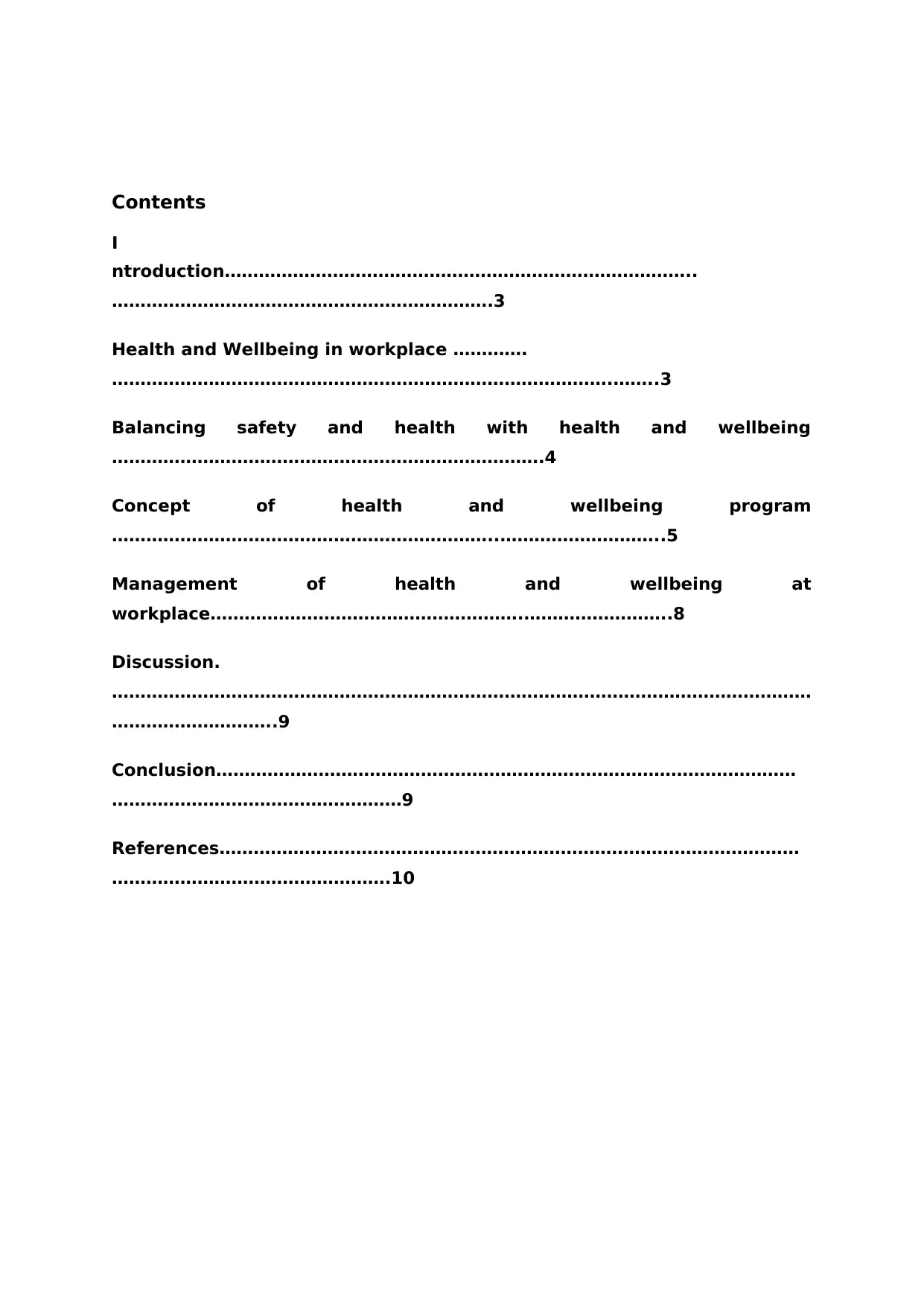
Contents
I
ntroduction………………………………………………………………………..
………………………………………………………….3
Health and Wellbeing in workplace ………….
…………………………………………………………………………….……..3
Balancing safety and health with health and wellbeing
………………………………………………………………….4
Concept of health and wellbeing program
…………………………………………………………..………………………..5
Management of health and wellbeing at
workplace……………………………………………….……………………..8
Discussion.
……………………………………………………………………………………………………………
………………………..9
Conclusion…………………………………………………………………………………………
……………………………………………9
References…………………………………………………………………………………………
………………………………………….10
I
ntroduction………………………………………………………………………..
………………………………………………………….3
Health and Wellbeing in workplace ………….
…………………………………………………………………………….……..3
Balancing safety and health with health and wellbeing
………………………………………………………………….4
Concept of health and wellbeing program
…………………………………………………………..………………………..5
Management of health and wellbeing at
workplace……………………………………………….……………………..8
Discussion.
……………………………………………………………………………………………………………
………………………..9
Conclusion…………………………………………………………………………………………
……………………………………………9
References…………………………………………………………………………………………
………………………………………….10
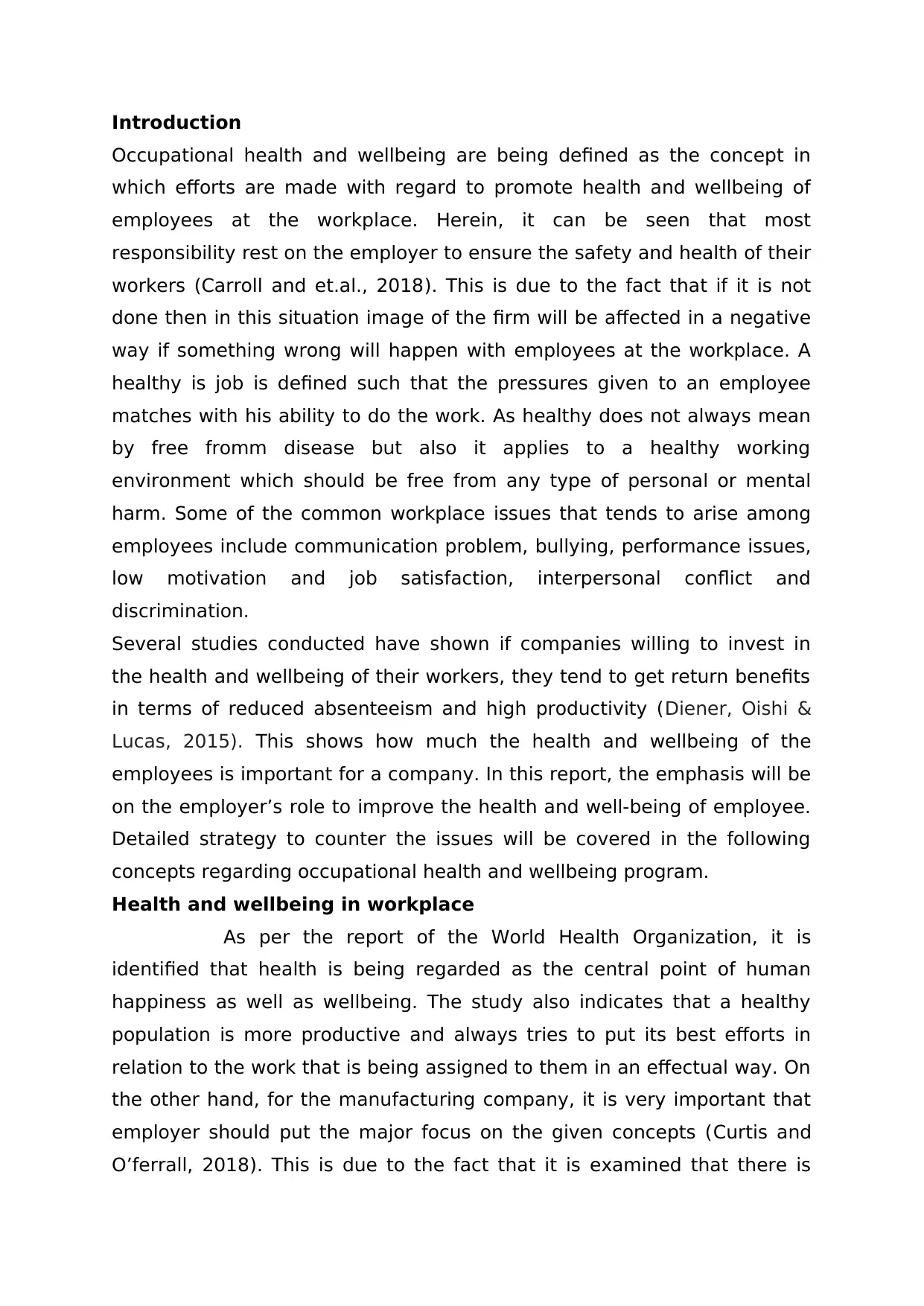
Introduction
Occupational health and wellbeing are being defined as the concept in
which efforts are made with regard to promote health and wellbeing of
employees at the workplace. Herein, it can be seen that most
responsibility rest on the employer to ensure the safety and health of their
workers (Carroll and et.al., 2018). This is due to the fact that if it is not
done then in this situation image of the firm will be affected in a negative
way if something wrong will happen with employees at the workplace. A
healthy is job is defined such that the pressures given to an employee
matches with his ability to do the work. As healthy does not always mean
by free fromm disease but also it applies to a healthy working
environment which should be free from any type of personal or mental
harm. Some of the common workplace issues that tends to arise among
employees include communication problem, bullying, performance issues,
low motivation and job satisfaction, interpersonal conflict and
discrimination.
Several studies conducted have shown if companies willing to invest in
the health and wellbeing of their workers, they tend to get return benefits
in terms of reduced absenteeism and high productivity (Diener, Oishi &
Lucas, 2015). This shows how much the health and wellbeing of the
employees is important for a company. In this report, the emphasis will be
on the employer’s role to improve the health and well-being of employee.
Detailed strategy to counter the issues will be covered in the following
concepts regarding occupational health and wellbeing program.
Health and wellbeing in workplace
As per the report of the World Health Organization, it is
identified that health is being regarded as the central point of human
happiness as well as wellbeing. The study also indicates that a healthy
population is more productive and always tries to put its best efforts in
relation to the work that is being assigned to them in an effectual way. On
the other hand, for the manufacturing company, it is very important that
employer should put the major focus on the given concepts (Curtis and
O’ferrall, 2018). This is due to the fact that it is examined that there is
Occupational health and wellbeing are being defined as the concept in
which efforts are made with regard to promote health and wellbeing of
employees at the workplace. Herein, it can be seen that most
responsibility rest on the employer to ensure the safety and health of their
workers (Carroll and et.al., 2018). This is due to the fact that if it is not
done then in this situation image of the firm will be affected in a negative
way if something wrong will happen with employees at the workplace. A
healthy is job is defined such that the pressures given to an employee
matches with his ability to do the work. As healthy does not always mean
by free fromm disease but also it applies to a healthy working
environment which should be free from any type of personal or mental
harm. Some of the common workplace issues that tends to arise among
employees include communication problem, bullying, performance issues,
low motivation and job satisfaction, interpersonal conflict and
discrimination.
Several studies conducted have shown if companies willing to invest in
the health and wellbeing of their workers, they tend to get return benefits
in terms of reduced absenteeism and high productivity (Diener, Oishi &
Lucas, 2015). This shows how much the health and wellbeing of the
employees is important for a company. In this report, the emphasis will be
on the employer’s role to improve the health and well-being of employee.
Detailed strategy to counter the issues will be covered in the following
concepts regarding occupational health and wellbeing program.
Health and wellbeing in workplace
As per the report of the World Health Organization, it is
identified that health is being regarded as the central point of human
happiness as well as wellbeing. The study also indicates that a healthy
population is more productive and always tries to put its best efforts in
relation to the work that is being assigned to them in an effectual way. On
the other hand, for the manufacturing company, it is very important that
employer should put the major focus on the given concepts (Curtis and
O’ferrall, 2018). This is due to the fact that it is examined that there is
⊘ This is a preview!⊘
Do you want full access?
Subscribe today to unlock all pages.

Trusted by 1+ million students worldwide
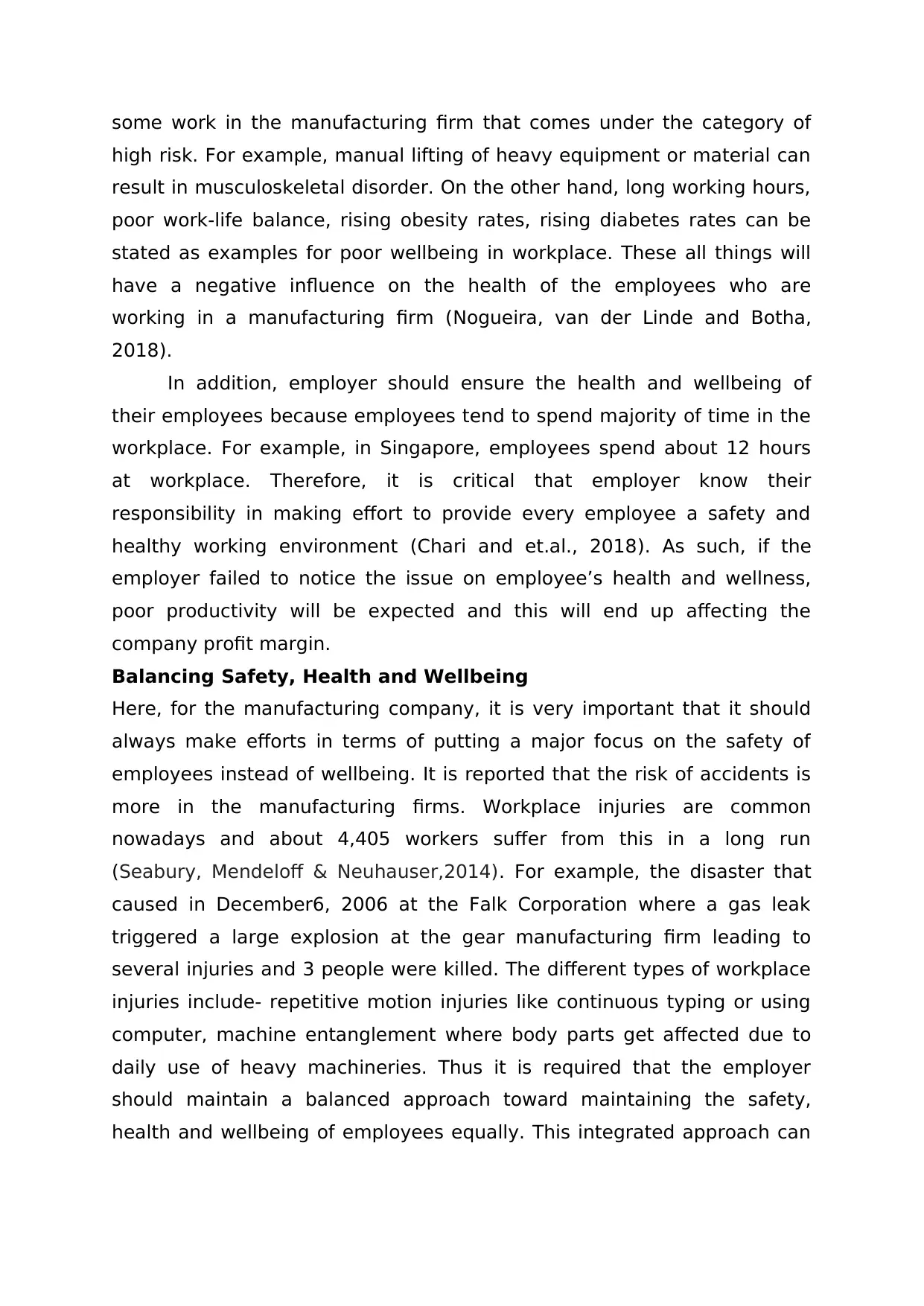
some work in the manufacturing firm that comes under the category of
high risk. For example, manual lifting of heavy equipment or material can
result in musculoskeletal disorder. On the other hand, long working hours,
poor work-life balance, rising obesity rates, rising diabetes rates can be
stated as examples for poor wellbeing in workplace. These all things will
have a negative influence on the health of the employees who are
working in a manufacturing firm (Nogueira, van der Linde and Botha,
2018).
In addition, employer should ensure the health and wellbeing of
their employees because employees tend to spend majority of time in the
workplace. For example, in Singapore, employees spend about 12 hours
at workplace. Therefore, it is critical that employer know their
responsibility in making effort to provide every employee a safety and
healthy working environment (Chari and et.al., 2018). As such, if the
employer failed to notice the issue on employee’s health and wellness,
poor productivity will be expected and this will end up affecting the
company profit margin.
Balancing Safety, Health and Wellbeing
Here, for the manufacturing company, it is very important that it should
always make efforts in terms of putting a major focus on the safety of
employees instead of wellbeing. It is reported that the risk of accidents is
more in the manufacturing firms. Workplace injuries are common
nowadays and about 4,405 workers suffer from this in a long run
(Seabury, Mendeloff & Neuhauser,2014). For example, the disaster that
caused in December6, 2006 at the Falk Corporation where a gas leak
triggered a large explosion at the gear manufacturing firm leading to
several injuries and 3 people were killed. The different types of workplace
injuries include- repetitive motion injuries like continuous typing or using
computer, machine entanglement where body parts get affected due to
daily use of heavy machineries. Thus it is required that the employer
should maintain a balanced approach toward maintaining the safety,
health and wellbeing of employees equally. This integrated approach can
high risk. For example, manual lifting of heavy equipment or material can
result in musculoskeletal disorder. On the other hand, long working hours,
poor work-life balance, rising obesity rates, rising diabetes rates can be
stated as examples for poor wellbeing in workplace. These all things will
have a negative influence on the health of the employees who are
working in a manufacturing firm (Nogueira, van der Linde and Botha,
2018).
In addition, employer should ensure the health and wellbeing of
their employees because employees tend to spend majority of time in the
workplace. For example, in Singapore, employees spend about 12 hours
at workplace. Therefore, it is critical that employer know their
responsibility in making effort to provide every employee a safety and
healthy working environment (Chari and et.al., 2018). As such, if the
employer failed to notice the issue on employee’s health and wellness,
poor productivity will be expected and this will end up affecting the
company profit margin.
Balancing Safety, Health and Wellbeing
Here, for the manufacturing company, it is very important that it should
always make efforts in terms of putting a major focus on the safety of
employees instead of wellbeing. It is reported that the risk of accidents is
more in the manufacturing firms. Workplace injuries are common
nowadays and about 4,405 workers suffer from this in a long run
(Seabury, Mendeloff & Neuhauser,2014). For example, the disaster that
caused in December6, 2006 at the Falk Corporation where a gas leak
triggered a large explosion at the gear manufacturing firm leading to
several injuries and 3 people were killed. The different types of workplace
injuries include- repetitive motion injuries like continuous typing or using
computer, machine entanglement where body parts get affected due to
daily use of heavy machineries. Thus it is required that the employer
should maintain a balanced approach toward maintaining the safety,
health and wellbeing of employees equally. This integrated approach can
Paraphrase This Document
Need a fresh take? Get an instant paraphrase of this document with our AI Paraphraser
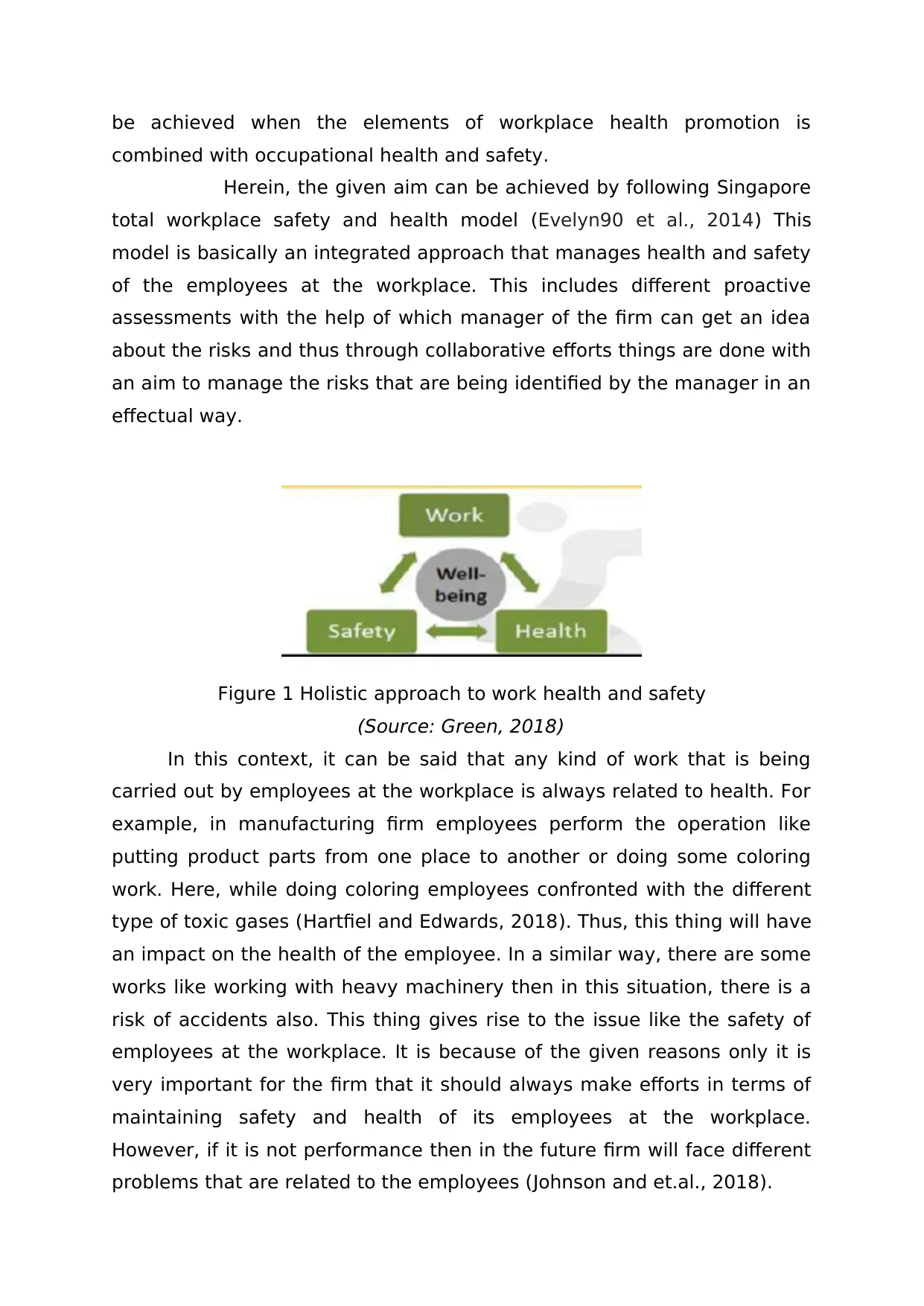
be achieved when the elements of workplace health promotion is
combined with occupational health and safety.
Herein, the given aim can be achieved by following Singapore
total workplace safety and health model (Evelyn90 et al., 2014) This
model is basically an integrated approach that manages health and safety
of the employees at the workplace. This includes different proactive
assessments with the help of which manager of the firm can get an idea
about the risks and thus through collaborative efforts things are done with
an aim to manage the risks that are being identified by the manager in an
effectual way.
Figure 1 Holistic approach to work health and safety
(Source: Green, 2018)
In this context, it can be said that any kind of work that is being
carried out by employees at the workplace is always related to health. For
example, in manufacturing firm employees perform the operation like
putting product parts from one place to another or doing some coloring
work. Here, while doing coloring employees confronted with the different
type of toxic gases (Hartfiel and Edwards, 2018). Thus, this thing will have
an impact on the health of the employee. In a similar way, there are some
works like working with heavy machinery then in this situation, there is a
risk of accidents also. This thing gives rise to the issue like the safety of
employees at the workplace. It is because of the given reasons only it is
very important for the firm that it should always make efforts in terms of
maintaining safety and health of its employees at the workplace.
However, if it is not performance then in the future firm will face different
problems that are related to the employees (Johnson and et.al., 2018).
combined with occupational health and safety.
Herein, the given aim can be achieved by following Singapore
total workplace safety and health model (Evelyn90 et al., 2014) This
model is basically an integrated approach that manages health and safety
of the employees at the workplace. This includes different proactive
assessments with the help of which manager of the firm can get an idea
about the risks and thus through collaborative efforts things are done with
an aim to manage the risks that are being identified by the manager in an
effectual way.
Figure 1 Holistic approach to work health and safety
(Source: Green, 2018)
In this context, it can be said that any kind of work that is being
carried out by employees at the workplace is always related to health. For
example, in manufacturing firm employees perform the operation like
putting product parts from one place to another or doing some coloring
work. Here, while doing coloring employees confronted with the different
type of toxic gases (Hartfiel and Edwards, 2018). Thus, this thing will have
an impact on the health of the employee. In a similar way, there are some
works like working with heavy machinery then in this situation, there is a
risk of accidents also. This thing gives rise to the issue like the safety of
employees at the workplace. It is because of the given reasons only it is
very important for the firm that it should always make efforts in terms of
maintaining safety and health of its employees at the workplace.
However, if it is not performance then in the future firm will face different
problems that are related to the employees (Johnson and et.al., 2018).
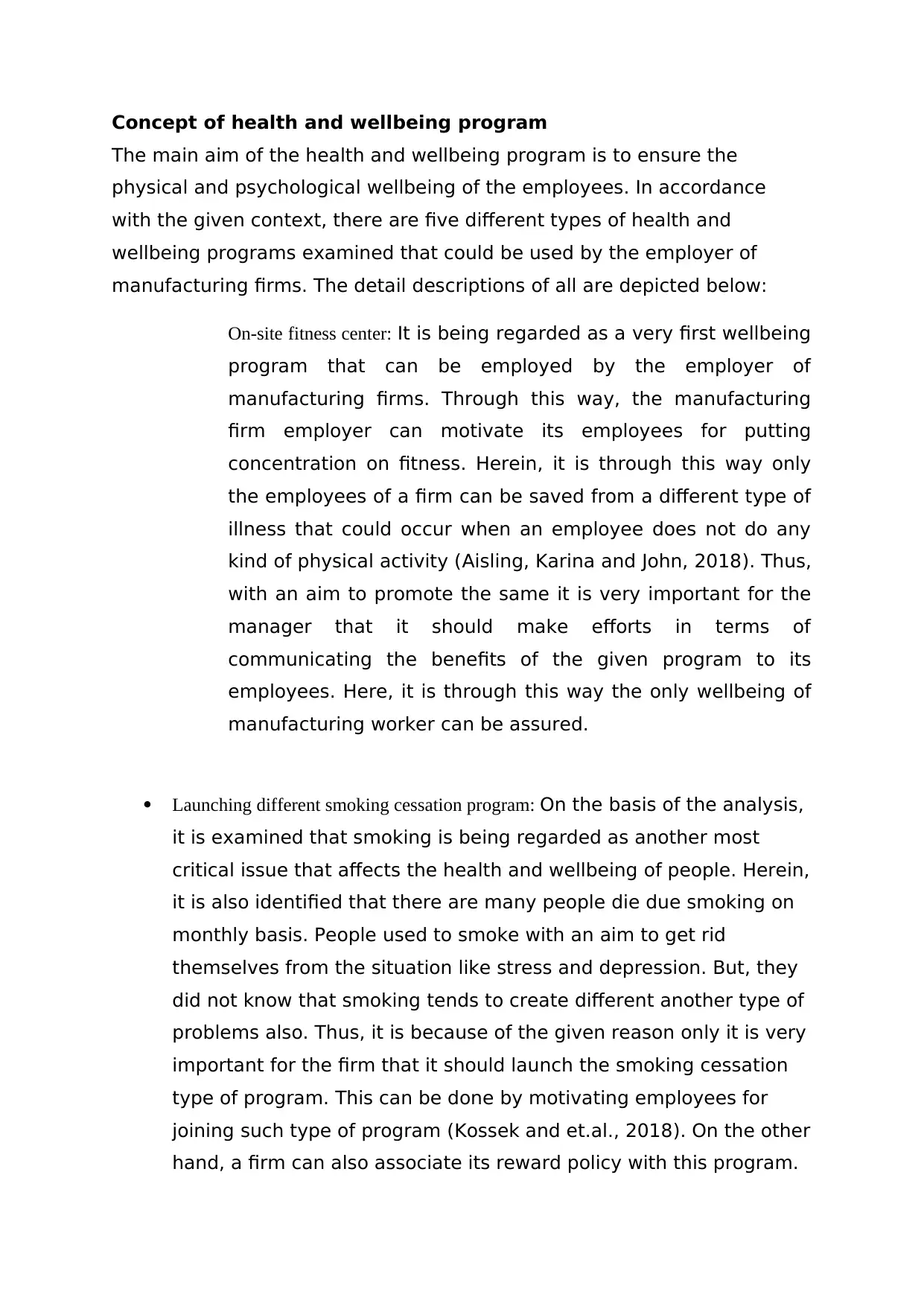
Concept of health and wellbeing program
The main aim of the health and wellbeing program is to ensure the
physical and psychological wellbeing of the employees. In accordance
with the given context, there are five different types of health and
wellbeing programs examined that could be used by the employer of
manufacturing firms. The detail descriptions of all are depicted below:
On-site fitness center: It is being regarded as a very first wellbeing
program that can be employed by the employer of
manufacturing firms. Through this way, the manufacturing
firm employer can motivate its employees for putting
concentration on fitness. Herein, it is through this way only
the employees of a firm can be saved from a different type of
illness that could occur when an employee does not do any
kind of physical activity (Aisling, Karina and John, 2018). Thus,
with an aim to promote the same it is very important for the
manager that it should make efforts in terms of
communicating the benefits of the given program to its
employees. Here, it is through this way the only wellbeing of
manufacturing worker can be assured.
Launching different smoking cessation program: On the basis of the analysis,
it is examined that smoking is being regarded as another most
critical issue that affects the health and wellbeing of people. Herein,
it is also identified that there are many people die due smoking on
monthly basis. People used to smoke with an aim to get rid
themselves from the situation like stress and depression. But, they
did not know that smoking tends to create different another type of
problems also. Thus, it is because of the given reason only it is very
important for the firm that it should launch the smoking cessation
type of program. This can be done by motivating employees for
joining such type of program (Kossek and et.al., 2018). On the other
hand, a firm can also associate its reward policy with this program.
The main aim of the health and wellbeing program is to ensure the
physical and psychological wellbeing of the employees. In accordance
with the given context, there are five different types of health and
wellbeing programs examined that could be used by the employer of
manufacturing firms. The detail descriptions of all are depicted below:
On-site fitness center: It is being regarded as a very first wellbeing
program that can be employed by the employer of
manufacturing firms. Through this way, the manufacturing
firm employer can motivate its employees for putting
concentration on fitness. Herein, it is through this way only
the employees of a firm can be saved from a different type of
illness that could occur when an employee does not do any
kind of physical activity (Aisling, Karina and John, 2018). Thus,
with an aim to promote the same it is very important for the
manager that it should make efforts in terms of
communicating the benefits of the given program to its
employees. Here, it is through this way the only wellbeing of
manufacturing worker can be assured.
Launching different smoking cessation program: On the basis of the analysis,
it is examined that smoking is being regarded as another most
critical issue that affects the health and wellbeing of people. Herein,
it is also identified that there are many people die due smoking on
monthly basis. People used to smoke with an aim to get rid
themselves from the situation like stress and depression. But, they
did not know that smoking tends to create different another type of
problems also. Thus, it is because of the given reason only it is very
important for the firm that it should launch the smoking cessation
type of program. This can be done by motivating employees for
joining such type of program (Kossek and et.al., 2018). On the other
hand, a firm can also associate its reward policy with this program.
⊘ This is a preview!⊘
Do you want full access?
Subscribe today to unlock all pages.

Trusted by 1+ million students worldwide
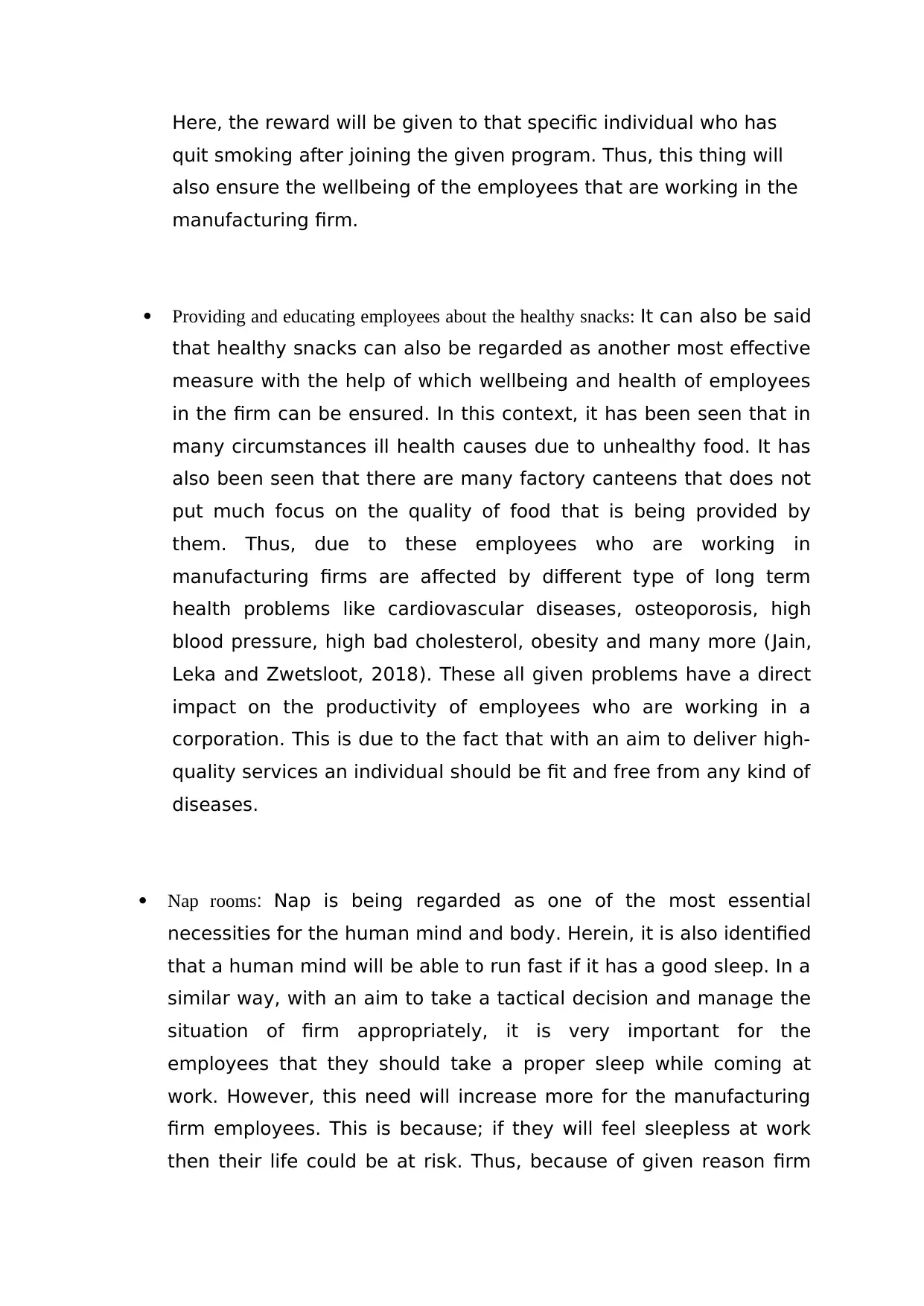
Here, the reward will be given to that specific individual who has
quit smoking after joining the given program. Thus, this thing will
also ensure the wellbeing of the employees that are working in the
manufacturing firm.
Providing and educating employees about the healthy snacks: It can also be said
that healthy snacks can also be regarded as another most effective
measure with the help of which wellbeing and health of employees
in the firm can be ensured. In this context, it has been seen that in
many circumstances ill health causes due to unhealthy food. It has
also been seen that there are many factory canteens that does not
put much focus on the quality of food that is being provided by
them. Thus, due to these employees who are working in
manufacturing firms are affected by different type of long term
health problems like cardiovascular diseases, osteoporosis, high
blood pressure, high bad cholesterol, obesity and many more (Jain,
Leka and Zwetsloot, 2018). These all given problems have a direct
impact on the productivity of employees who are working in a
corporation. This is due to the fact that with an aim to deliver high-
quality services an individual should be fit and free from any kind of
diseases.
Nap rooms: Nap is being regarded as one of the most essential
necessities for the human mind and body. Herein, it is also identified
that a human mind will be able to run fast if it has a good sleep. In a
similar way, with an aim to take a tactical decision and manage the
situation of firm appropriately, it is very important for the
employees that they should take a proper sleep while coming at
work. However, this need will increase more for the manufacturing
firm employees. This is because; if they will feel sleepless at work
then their life could be at risk. Thus, because of given reason firm
quit smoking after joining the given program. Thus, this thing will
also ensure the wellbeing of the employees that are working in the
manufacturing firm.
Providing and educating employees about the healthy snacks: It can also be said
that healthy snacks can also be regarded as another most effective
measure with the help of which wellbeing and health of employees
in the firm can be ensured. In this context, it has been seen that in
many circumstances ill health causes due to unhealthy food. It has
also been seen that there are many factory canteens that does not
put much focus on the quality of food that is being provided by
them. Thus, due to these employees who are working in
manufacturing firms are affected by different type of long term
health problems like cardiovascular diseases, osteoporosis, high
blood pressure, high bad cholesterol, obesity and many more (Jain,
Leka and Zwetsloot, 2018). These all given problems have a direct
impact on the productivity of employees who are working in a
corporation. This is due to the fact that with an aim to deliver high-
quality services an individual should be fit and free from any kind of
diseases.
Nap rooms: Nap is being regarded as one of the most essential
necessities for the human mind and body. Herein, it is also identified
that a human mind will be able to run fast if it has a good sleep. In a
similar way, with an aim to take a tactical decision and manage the
situation of firm appropriately, it is very important for the
employees that they should take a proper sleep while coming at
work. However, this need will increase more for the manufacturing
firm employees. This is because; if they will feel sleepless at work
then their life could be at risk. Thus, because of given reason firm
Paraphrase This Document
Need a fresh take? Get an instant paraphrase of this document with our AI Paraphraser
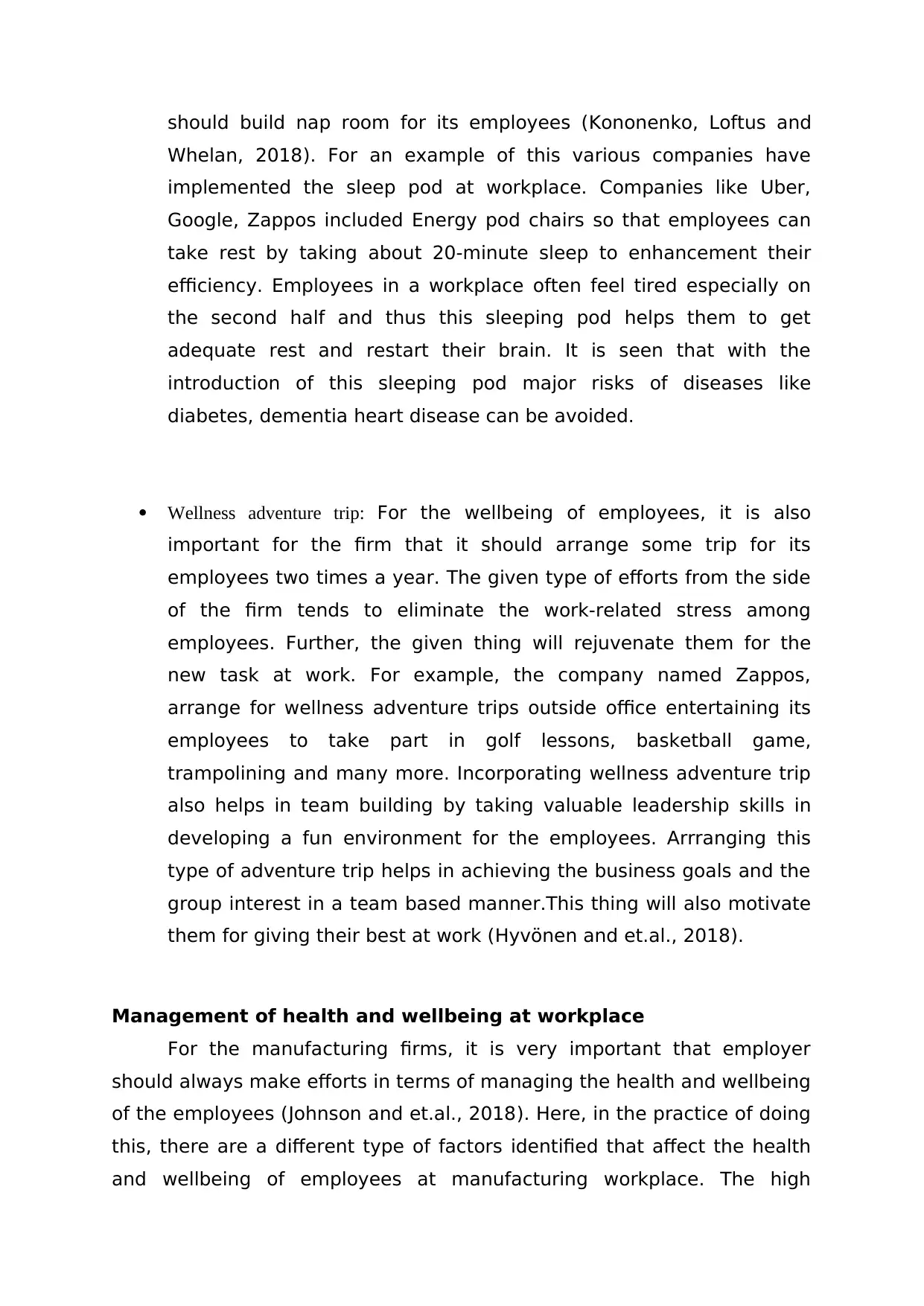
should build nap room for its employees (Kononenko, Loftus and
Whelan, 2018). For an example of this various companies have
implemented the sleep pod at workplace. Companies like Uber,
Google, Zappos included Energy pod chairs so that employees can
take rest by taking about 20-minute sleep to enhancement their
efficiency. Employees in a workplace often feel tired especially on
the second half and thus this sleeping pod helps them to get
adequate rest and restart their brain. It is seen that with the
introduction of this sleeping pod major risks of diseases like
diabetes, dementia heart disease can be avoided.
Wellness adventure trip: For the wellbeing of employees, it is also
important for the firm that it should arrange some trip for its
employees two times a year. The given type of efforts from the side
of the firm tends to eliminate the work-related stress among
employees. Further, the given thing will rejuvenate them for the
new task at work. For example, the company named Zappos,
arrange for wellness adventure trips outside office entertaining its
employees to take part in golf lessons, basketball game,
trampolining and many more. Incorporating wellness adventure trip
also helps in team building by taking valuable leadership skills in
developing a fun environment for the employees. Arrranging this
type of adventure trip helps in achieving the business goals and the
group interest in a team based manner.This thing will also motivate
them for giving their best at work (Hyvönen and et.al., 2018).
Management of health and wellbeing at workplace
For the manufacturing firms, it is very important that employer
should always make efforts in terms of managing the health and wellbeing
of the employees (Johnson and et.al., 2018). Here, in the practice of doing
this, there are a different type of factors identified that affect the health
and wellbeing of employees at manufacturing workplace. The high
Whelan, 2018). For an example of this various companies have
implemented the sleep pod at workplace. Companies like Uber,
Google, Zappos included Energy pod chairs so that employees can
take rest by taking about 20-minute sleep to enhancement their
efficiency. Employees in a workplace often feel tired especially on
the second half and thus this sleeping pod helps them to get
adequate rest and restart their brain. It is seen that with the
introduction of this sleeping pod major risks of diseases like
diabetes, dementia heart disease can be avoided.
Wellness adventure trip: For the wellbeing of employees, it is also
important for the firm that it should arrange some trip for its
employees two times a year. The given type of efforts from the side
of the firm tends to eliminate the work-related stress among
employees. Further, the given thing will rejuvenate them for the
new task at work. For example, the company named Zappos,
arrange for wellness adventure trips outside office entertaining its
employees to take part in golf lessons, basketball game,
trampolining and many more. Incorporating wellness adventure trip
also helps in team building by taking valuable leadership skills in
developing a fun environment for the employees. Arrranging this
type of adventure trip helps in achieving the business goals and the
group interest in a team based manner.This thing will also motivate
them for giving their best at work (Hyvönen and et.al., 2018).
Management of health and wellbeing at workplace
For the manufacturing firms, it is very important that employer
should always make efforts in terms of managing the health and wellbeing
of the employees (Johnson and et.al., 2018). Here, in the practice of doing
this, there are a different type of factors identified that affect the health
and wellbeing of employees at manufacturing workplace. The high
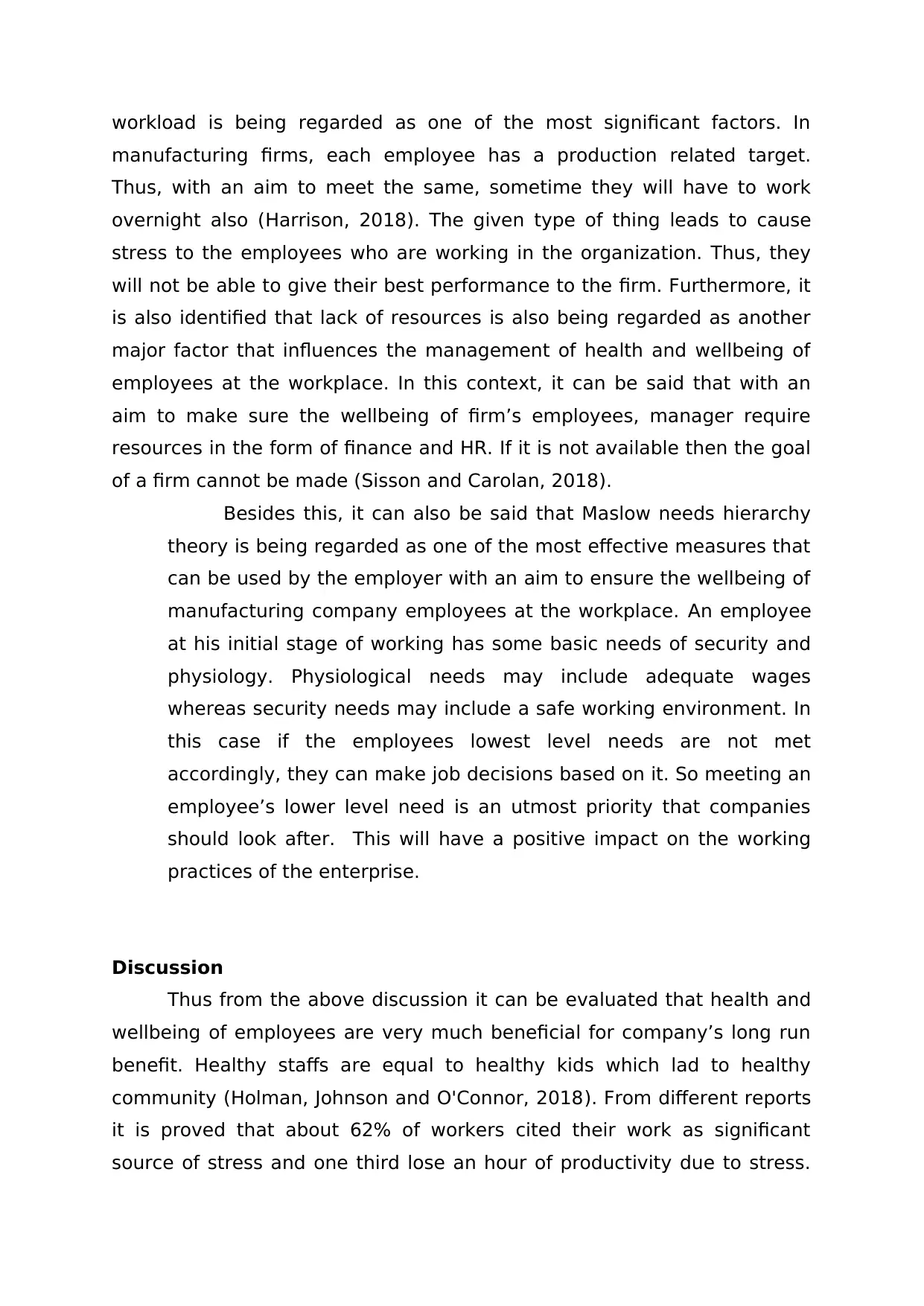
workload is being regarded as one of the most significant factors. In
manufacturing firms, each employee has a production related target.
Thus, with an aim to meet the same, sometime they will have to work
overnight also (Harrison, 2018). The given type of thing leads to cause
stress to the employees who are working in the organization. Thus, they
will not be able to give their best performance to the firm. Furthermore, it
is also identified that lack of resources is also being regarded as another
major factor that influences the management of health and wellbeing of
employees at the workplace. In this context, it can be said that with an
aim to make sure the wellbeing of firm’s employees, manager require
resources in the form of finance and HR. If it is not available then the goal
of a firm cannot be made (Sisson and Carolan, 2018).
Besides this, it can also be said that Maslow needs hierarchy
theory is being regarded as one of the most effective measures that
can be used by the employer with an aim to ensure the wellbeing of
manufacturing company employees at the workplace. An employee
at his initial stage of working has some basic needs of security and
physiology. Physiological needs may include adequate wages
whereas security needs may include a safe working environment. In
this case if the employees lowest level needs are not met
accordingly, they can make job decisions based on it. So meeting an
employee’s lower level need is an utmost priority that companies
should look after. This will have a positive impact on the working
practices of the enterprise.
Discussion
Thus from the above discussion it can be evaluated that health and
wellbeing of employees are very much beneficial for company’s long run
benefit. Healthy staffs are equal to healthy kids which lad to healthy
community (Holman, Johnson and O'Connor, 2018). From different reports
it is proved that about 62% of workers cited their work as significant
source of stress and one third lose an hour of productivity due to stress.
manufacturing firms, each employee has a production related target.
Thus, with an aim to meet the same, sometime they will have to work
overnight also (Harrison, 2018). The given type of thing leads to cause
stress to the employees who are working in the organization. Thus, they
will not be able to give their best performance to the firm. Furthermore, it
is also identified that lack of resources is also being regarded as another
major factor that influences the management of health and wellbeing of
employees at the workplace. In this context, it can be said that with an
aim to make sure the wellbeing of firm’s employees, manager require
resources in the form of finance and HR. If it is not available then the goal
of a firm cannot be made (Sisson and Carolan, 2018).
Besides this, it can also be said that Maslow needs hierarchy
theory is being regarded as one of the most effective measures that
can be used by the employer with an aim to ensure the wellbeing of
manufacturing company employees at the workplace. An employee
at his initial stage of working has some basic needs of security and
physiology. Physiological needs may include adequate wages
whereas security needs may include a safe working environment. In
this case if the employees lowest level needs are not met
accordingly, they can make job decisions based on it. So meeting an
employee’s lower level need is an utmost priority that companies
should look after. This will have a positive impact on the working
practices of the enterprise.
Discussion
Thus from the above discussion it can be evaluated that health and
wellbeing of employees are very much beneficial for company’s long run
benefit. Healthy staffs are equal to healthy kids which lad to healthy
community (Holman, Johnson and O'Connor, 2018). From different reports
it is proved that about 62% of workers cited their work as significant
source of stress and one third lose an hour of productivity due to stress.
⊘ This is a preview!⊘
Do you want full access?
Subscribe today to unlock all pages.

Trusted by 1+ million students worldwide
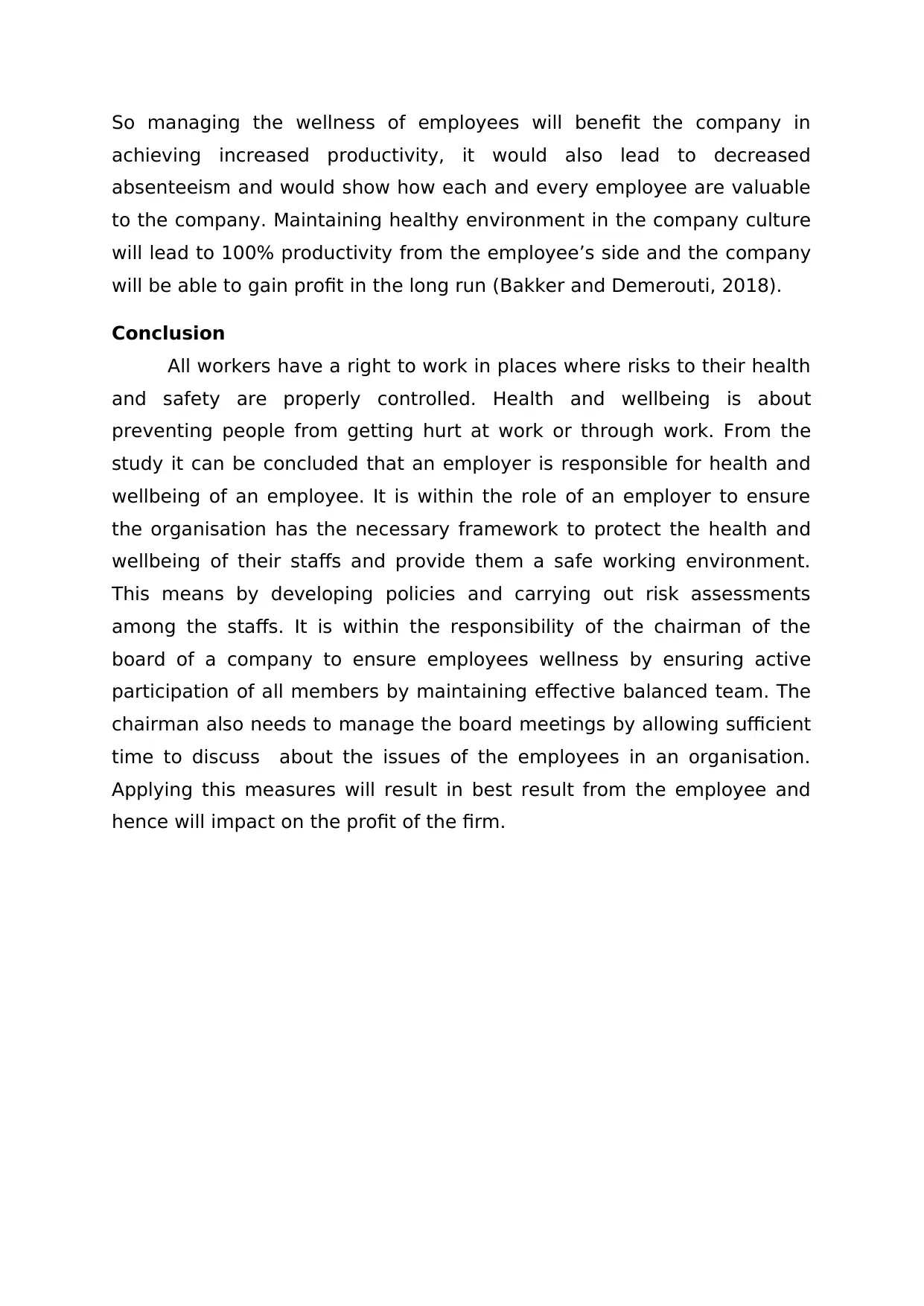
So managing the wellness of employees will benefit the company in
achieving increased productivity, it would also lead to decreased
absenteeism and would show how each and every employee are valuable
to the company. Maintaining healthy environment in the company culture
will lead to 100% productivity from the employee’s side and the company
will be able to gain profit in the long run (Bakker and Demerouti, 2018).
Conclusion
All workers have a right to work in places where risks to their health
and safety are properly controlled. Health and wellbeing is about
preventing people from getting hurt at work or through work. From the
study it can be concluded that an employer is responsible for health and
wellbeing of an employee. It is within the role of an employer to ensure
the organisation has the necessary framework to protect the health and
wellbeing of their staffs and provide them a safe working environment.
This means by developing policies and carrying out risk assessments
among the staffs. It is within the responsibility of the chairman of the
board of a company to ensure employees wellness by ensuring active
participation of all members by maintaining effective balanced team. The
chairman also needs to manage the board meetings by allowing sufficient
time to discuss about the issues of the employees in an organisation.
Applying this measures will result in best result from the employee and
hence will impact on the profit of the firm.
achieving increased productivity, it would also lead to decreased
absenteeism and would show how each and every employee are valuable
to the company. Maintaining healthy environment in the company culture
will lead to 100% productivity from the employee’s side and the company
will be able to gain profit in the long run (Bakker and Demerouti, 2018).
Conclusion
All workers have a right to work in places where risks to their health
and safety are properly controlled. Health and wellbeing is about
preventing people from getting hurt at work or through work. From the
study it can be concluded that an employer is responsible for health and
wellbeing of an employee. It is within the role of an employer to ensure
the organisation has the necessary framework to protect the health and
wellbeing of their staffs and provide them a safe working environment.
This means by developing policies and carrying out risk assessments
among the staffs. It is within the responsibility of the chairman of the
board of a company to ensure employees wellness by ensuring active
participation of all members by maintaining effective balanced team. The
chairman also needs to manage the board meetings by allowing sufficient
time to discuss about the issues of the employees in an organisation.
Applying this measures will result in best result from the employee and
hence will impact on the profit of the firm.
Paraphrase This Document
Need a fresh take? Get an instant paraphrase of this document with our AI Paraphraser
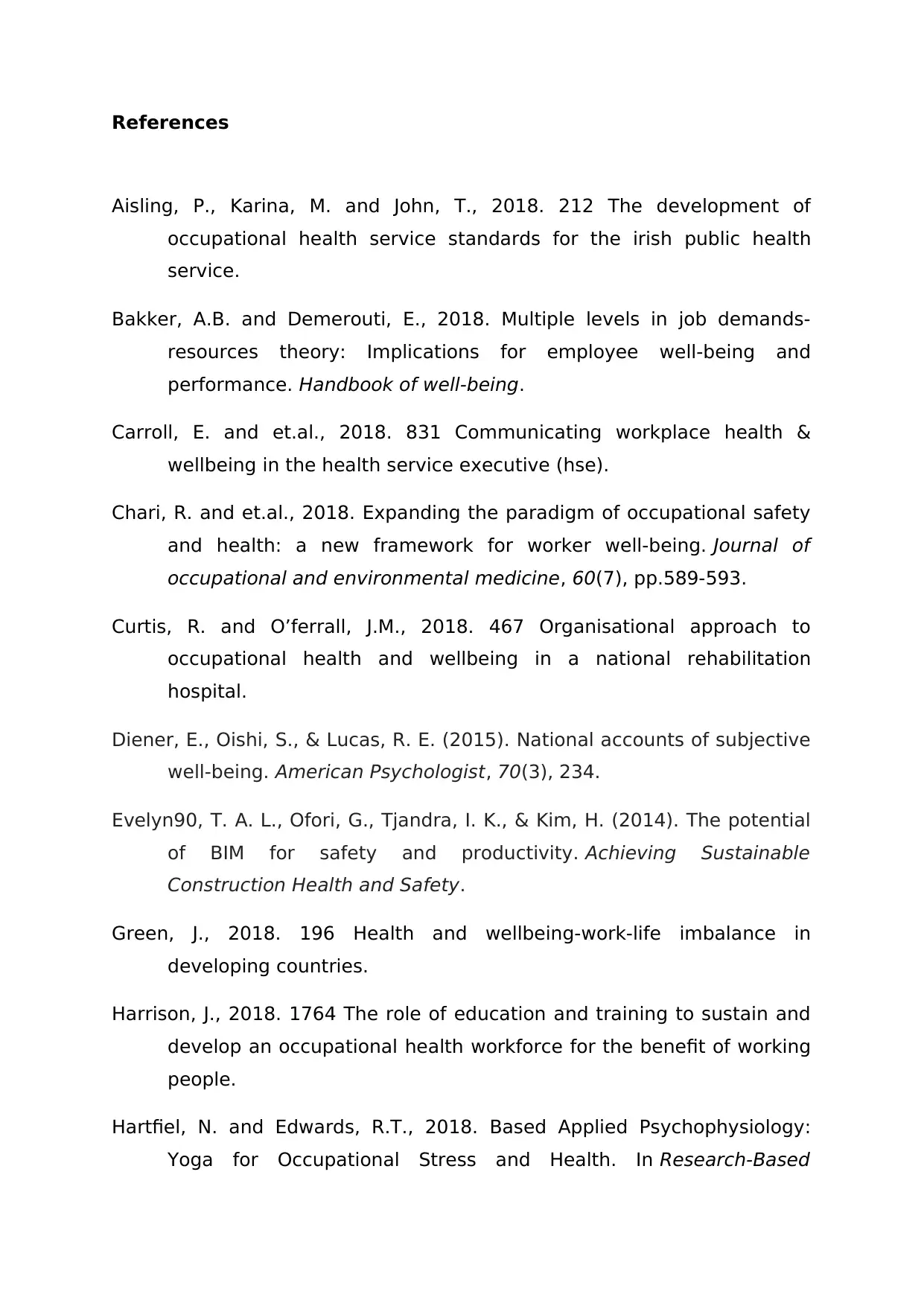
References
Aisling, P., Karina, M. and John, T., 2018. 212 The development of
occupational health service standards for the irish public health
service.
Bakker, A.B. and Demerouti, E., 2018. Multiple levels in job demands-
resources theory: Implications for employee well-being and
performance. Handbook of well-being.
Carroll, E. and et.al., 2018. 831 Communicating workplace health &
wellbeing in the health service executive (hse).
Chari, R. and et.al., 2018. Expanding the paradigm of occupational safety
and health: a new framework for worker well-being. Journal of
occupational and environmental medicine, 60(7), pp.589-593.
Curtis, R. and O’ferrall, J.M., 2018. 467 Organisational approach to
occupational health and wellbeing in a national rehabilitation
hospital.
Diener, E., Oishi, S., & Lucas, R. E. (2015). National accounts of subjective
well-being. American Psychologist, 70(3), 234.
Evelyn90, T. A. L., Ofori, G., Tjandra, I. K., & Kim, H. (2014). The potential
of BIM for safety and productivity. Achieving Sustainable
Construction Health and Safety.
Green, J., 2018. 196 Health and wellbeing-work-life imbalance in
developing countries.
Harrison, J., 2018. 1764 The role of education and training to sustain and
develop an occupational health workforce for the benefit of working
people.
Hartfiel, N. and Edwards, R.T., 2018. Based Applied Psychophysiology:
Yoga for Occupational Stress and Health. In Research-Based
Aisling, P., Karina, M. and John, T., 2018. 212 The development of
occupational health service standards for the irish public health
service.
Bakker, A.B. and Demerouti, E., 2018. Multiple levels in job demands-
resources theory: Implications for employee well-being and
performance. Handbook of well-being.
Carroll, E. and et.al., 2018. 831 Communicating workplace health &
wellbeing in the health service executive (hse).
Chari, R. and et.al., 2018. Expanding the paradigm of occupational safety
and health: a new framework for worker well-being. Journal of
occupational and environmental medicine, 60(7), pp.589-593.
Curtis, R. and O’ferrall, J.M., 2018. 467 Organisational approach to
occupational health and wellbeing in a national rehabilitation
hospital.
Diener, E., Oishi, S., & Lucas, R. E. (2015). National accounts of subjective
well-being. American Psychologist, 70(3), 234.
Evelyn90, T. A. L., Ofori, G., Tjandra, I. K., & Kim, H. (2014). The potential
of BIM for safety and productivity. Achieving Sustainable
Construction Health and Safety.
Green, J., 2018. 196 Health and wellbeing-work-life imbalance in
developing countries.
Harrison, J., 2018. 1764 The role of education and training to sustain and
develop an occupational health workforce for the benefit of working
people.
Hartfiel, N. and Edwards, R.T., 2018. Based Applied Psychophysiology:
Yoga for Occupational Stress and Health. In Research-Based
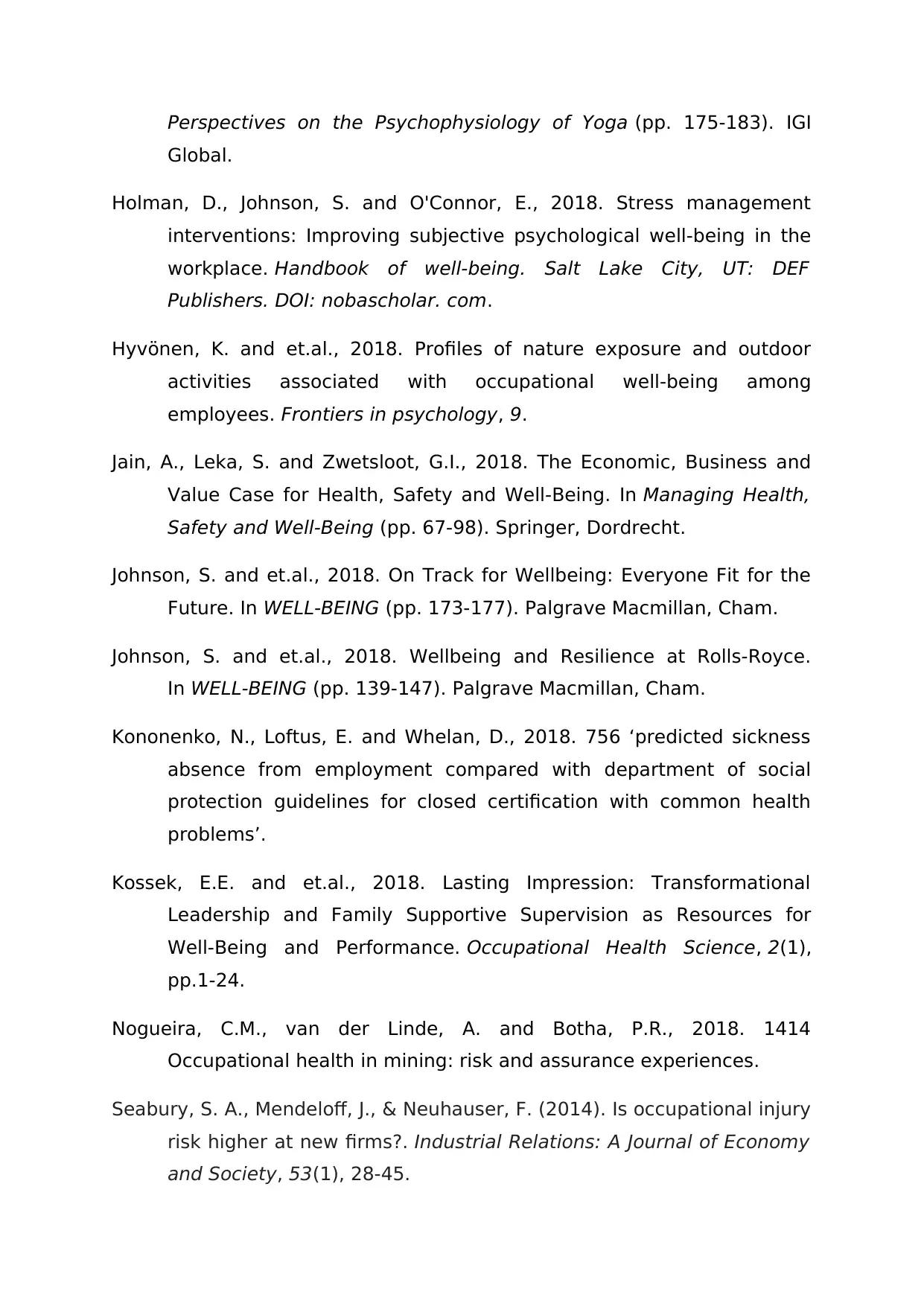
Perspectives on the Psychophysiology of Yoga (pp. 175-183). IGI
Global.
Holman, D., Johnson, S. and O'Connor, E., 2018. Stress management
interventions: Improving subjective psychological well-being in the
workplace. Handbook of well-being. Salt Lake City, UT: DEF
Publishers. DOI: nobascholar. com.
Hyvönen, K. and et.al., 2018. Profiles of nature exposure and outdoor
activities associated with occupational well-being among
employees. Frontiers in psychology, 9.
Jain, A., Leka, S. and Zwetsloot, G.I., 2018. The Economic, Business and
Value Case for Health, Safety and Well-Being. In Managing Health,
Safety and Well-Being (pp. 67-98). Springer, Dordrecht.
Johnson, S. and et.al., 2018. On Track for Wellbeing: Everyone Fit for the
Future. In WELL-BEING (pp. 173-177). Palgrave Macmillan, Cham.
Johnson, S. and et.al., 2018. Wellbeing and Resilience at Rolls-Royce.
In WELL-BEING (pp. 139-147). Palgrave Macmillan, Cham.
Kononenko, N., Loftus, E. and Whelan, D., 2018. 756 ‘predicted sickness
absence from employment compared with department of social
protection guidelines for closed certification with common health
problems’.
Kossek, E.E. and et.al., 2018. Lasting Impression: Transformational
Leadership and Family Supportive Supervision as Resources for
Well-Being and Performance. Occupational Health Science, 2(1),
pp.1-24.
Nogueira, C.M., van der Linde, A. and Botha, P.R., 2018. 1414
Occupational health in mining: risk and assurance experiences.
Seabury, S. A., Mendeloff, J., & Neuhauser, F. (2014). Is occupational injury
risk higher at new firms?. Industrial Relations: A Journal of Economy
and Society, 53(1), 28-45.
Global.
Holman, D., Johnson, S. and O'Connor, E., 2018. Stress management
interventions: Improving subjective psychological well-being in the
workplace. Handbook of well-being. Salt Lake City, UT: DEF
Publishers. DOI: nobascholar. com.
Hyvönen, K. and et.al., 2018. Profiles of nature exposure and outdoor
activities associated with occupational well-being among
employees. Frontiers in psychology, 9.
Jain, A., Leka, S. and Zwetsloot, G.I., 2018. The Economic, Business and
Value Case for Health, Safety and Well-Being. In Managing Health,
Safety and Well-Being (pp. 67-98). Springer, Dordrecht.
Johnson, S. and et.al., 2018. On Track for Wellbeing: Everyone Fit for the
Future. In WELL-BEING (pp. 173-177). Palgrave Macmillan, Cham.
Johnson, S. and et.al., 2018. Wellbeing and Resilience at Rolls-Royce.
In WELL-BEING (pp. 139-147). Palgrave Macmillan, Cham.
Kononenko, N., Loftus, E. and Whelan, D., 2018. 756 ‘predicted sickness
absence from employment compared with department of social
protection guidelines for closed certification with common health
problems’.
Kossek, E.E. and et.al., 2018. Lasting Impression: Transformational
Leadership and Family Supportive Supervision as Resources for
Well-Being and Performance. Occupational Health Science, 2(1),
pp.1-24.
Nogueira, C.M., van der Linde, A. and Botha, P.R., 2018. 1414
Occupational health in mining: risk and assurance experiences.
Seabury, S. A., Mendeloff, J., & Neuhauser, F. (2014). Is occupational injury
risk higher at new firms?. Industrial Relations: A Journal of Economy
and Society, 53(1), 28-45.
⊘ This is a preview!⊘
Do you want full access?
Subscribe today to unlock all pages.

Trusted by 1+ million students worldwide
1 out of 13
Related Documents
Your All-in-One AI-Powered Toolkit for Academic Success.
+13062052269
info@desklib.com
Available 24*7 on WhatsApp / Email
![[object Object]](/_next/static/media/star-bottom.7253800d.svg)
Unlock your academic potential
Copyright © 2020–2025 A2Z Services. All Rights Reserved. Developed and managed by ZUCOL.




